| CHOOSING THE RIGHT PAPER FOR PRINTING |
 |
|
Choosing the right type of ink jet paper for your photograph or fine art print can take your artwork from beautiful to over-the-top. Likewise, choosing the wrong paper can take away some of the vital visual aspects of the piece.
This article discusses the paper and image qualities you should be aware of in order to pick the best paper for each individual image.
To read more about the features and specs of different papers, please see our Inkjet Papers article.
To get started browsing papers and ordering prints, visit our Fine Art Prints service page.
|
OUR INKJET PAPERS
| PAPER NAME |
BEST FOR: |
| Hahnemuhle Photo Rag, Bright White |
Images with lots of detail and bold color; prints of original artwork in acrylics or oils. |
| Hahnemuhle German Etching, Textured |
Subjects with texture that will be emphasized by the paper; any print of an original that was on watercolor paper. |
| Moab Photo Rag |
Images with lots of detail and bold color; prints of original artwork in acrylics or oils. |
| Epson Enhanced Matte Paper |
Photographs which require a non-glossy surface; prints to be displayed under harsh lighting - no glare; images where vibrant color is not essential. |
| Metallic Photographic Paper |
Images featuring metal elements, such as vehicles, tin-sided buildings, bronze sculpture, etc. |
| Luster Photographic Paper |
High resolution images; landscape and nature photographs; good for prints being framed on the wall - still some gloss, but less glare. |
| Glossy Photographic Paper |
Images with plenty of color and a lot of tonal variation, such as black and white; creates rich, deep color. |
| Semi-Gloss Photographic Paper |
High resolution images with a lot of tonal variation, such as black and white; landscape and nature photographs. |
| Ink Jet Canvas |
Any image, including those with low resolution (pixelation); images with textured subjects; not ideal for dark images |
|
IMAGE QUALITIES
| YOUR IMAGE HAS: |
BEST PAPER TYPE: |
| High contrast black and white (grayscale) or color images |
Gloss, semi-gloss, or metallic photographic, or baryta, paper |
| Low resolution (due to camera quality or large print size) |
Canvas, or textured watercolor paper |
| Simple subject matter, no small details (ie: pure blue sky) |
Canvas, or textured watercolor paper will add interest. Smooth photo rag papers will also work. |
| A lot of fine detail, distinct design or distant subjects |
Smooth photo rag matte, or gloss photograph papers |
| Been digitized from an original watercolor painting |
A textured, cold press watercolor paper similar to the original |
| Been digitized from an original acrylic or oil painting |
A smooth, matte photo rag paper |
| A lot of dark areas, perhaps with low contrast |
Glossy or smooth photo rag papers; avoid canvas |
| A lot of color variation and vibrancy |
Photographic papers, any paper with a high color gamut. |
| A lot of modern or metal details, or a moody quality |
Metallic photographic paper |
| Very rich, deep blacks |
A paper with a DMax value of 2.0 for photographic papers, and minimum 1.7 for matte papers. |
| A wide range of colors, with many different tints or shades of certain colors. |
A paper with a wide color gamut. This is generally included in the basic description of the paper. Look for "very wide" or "very large." |
| Crisp, sharp images such as HDR photographs |
A smooth photo paper with a wide color gamut. Gloss, semi-gloss or metallic is best. |
| The need for very smooth transitions between different tones, shades, tints of the same color |
A smooth, untextured paper. Photo rag is ideal, though semi-gloss and metallic photo papers work as well. |
|
| GENERAL CONSIDERATIONS
|
 |
|
When beginning to choose a paper for a print, imagine what you want to see in the final display. How will you be hanging the piece - with or without glass? Frameless or within a large frame? Knowing these things beforehand can help you to envision how the end result will look on each type of paper.
Buying sample packs of papers from different brands is a great way to get a feel for what's out there. If you are determined to use a specific printer - either you own, or a printing company like us - you can narrow down your choices based on what they offer, or what that printer is capable of printing.
If you're planning to choose paper first, there are a lot of options. Thumb through different packs to get an idea of texture, thickness, opacity (transparency) and so on, and set aside the pieces that immediately strike you as potentials.
That said, it's a good idea to choose at least one paper from a few different categories, such as matte, luster, and glossy. As we'll discuss below, some images will look better on certain paper finishes than others.
PRINT PERMANENCE
It is important to think about how long you want your images to survive. Photographic papers can last up to 100 years if well taken care of, but if you want your image to be passed down for generations - a print of a special original painting, or an important family photo - you may want to select a paper made from 100% cotton. This will prevent yellowing and degradation from ruining the image, and can last for hundreds of years.
While a bright white paper is often desirable, for images of great importance you may want to choose a paper that does not have any artificial brighteners, as these can break down over time.
BLACKS
If your image is heavy on black, this should play into your decision. Matte papers use a different black ink than glossy photographic papers.
COLOR GAMUT
This relates to the range of colors a type of paper is capable of displaying. Depending on the tonals differences between colors, you may want a paper with higher color gamut, or it may not matter for that particular image. Color gamut is not as important for a three-color image, for instance, as it is for a black and white image with seventeen different shades of gray.
PAPER TEXTURE
Though other considerations should probably take precedence over this one, the feel of the paper can become important if you sell a lot of unframed prints. Your painting printed on a thick, richly textured watercolor paper will appeal more to a buyer than the same image printed on a basic, glossy photographic paper.
|
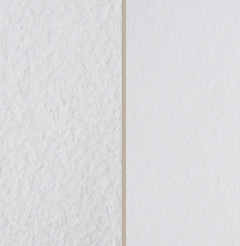
Left: Rough textured, cold press
Right: Smooth textured, hot press
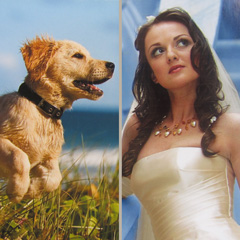
Left: Matte finish Photo Rag paper
Right: Glossy finish photo paper
|
| THE BEST PAPER FOR AN IMAGE
|
 |
|
Selecting the best paper for each image is a very individualized process that depends on what feel the artist wants their finished print to have. The best way to figure it out is to print the same image on a number of different papers. Eventually you'll figure out what papers suit your unique tastes and artwork!
That said, some qualities of an image lend themselves better to certain types of paper.
PATTERNS
A paper with any kind of texture might conceal important details in a busy image with ornamental designs or a skyline of tiny but distinct houses.
In such cases, a smooth paper - hot press - without any unnecessary texture is often a good choice.
TEXTURE
Sometimes the paper's texture can help highlight the textures of photographed objects. For instance, a picture of a bedroom with a rough old quilt spread over the bed could suit a cold press watercolor paper quite well. The almost sandy texture of a luster photographic paper could also work.
SUBJECT MATERIAL
Along the same lines, if the materials from which the subject of an image were made are well suited to a certain type of paper, it's likely a good fit. For instance, a photograph of a vehicle, grain silo, or old tin warehouse can look great on a metallic photographic paper. The iridescent hue will bring out the shininess of the metal.
ORIGINAL PAPER
You can't really go wrong if you choose to recreate an original on the same type of paper it was painted or drawn on in the first place. For instance, watercolor prints will always look lovely on a cold press, watercolor paper, and charcoal prints look great on a smooth, only slightly pock-marked surface. Likewise, digital images imitating these media will look good on the paper of their inspiration.
GRAYSCALE
Often, papers with a glossy finish - such as gloss or semi-gloss photographic, or baryta fiber-based paper - are the perfect fit to black and white images, because they keep the sharpness of the image, and work well in photos where minor changes in tone (very dark gray to light black, for instance) are essential to the image.
|
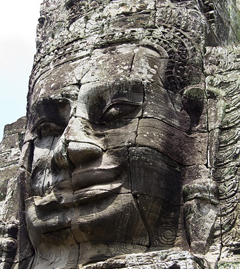
By printing on a textured paper, the roughness of the statue is brought to life.
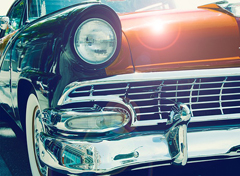
Keep the vibrancy of the chrome details by printing on metallic paper.
|
| GLOSSARY OF TERMS
|
 |
The following glossary defines the terms most commonly seen on the specs page of fine art printer papers.
DMax
Refers to the deepest black the paper can reproduce, which translates to stronger shadows and denser color. DMax is shown as a low number; 2.0 is a good value for photographic, glossy papers, and 1.7 is good for matte papers.
Color Gamut
The full range of colors a paper is able to display. It applies primarily to highly saturated colors in the image, and is generally described as "large" or "wide" in the product's description. Range of color also relies on the color gamut of the inks and printer.
Brightness
Refers to how much blue light is reflected off the paper. This measurement can be anywhere from 1 to more than 100 (which means more light is reflected than was directed at the paper). A more specific measurement than Whiteness
Whiteness
Refers to the reflectance of any light off the paper. Like brightness, the measurement is a percentage that can be above 100. Bright white papers often have a whiteness of 100-105%. A more general measurement than Brightness.
Weight
Paper weight is generally measured in GSM, which stands for "grams per square meter." In other words, one square meter of the paper (3 square feet) will weigh the amount listed on the specs sheet.
Caliper
The thickness of the paper, as measures in mils. One mil is 1/1000th of an inch. Most fine art papers have a caliper of 13 - 30 mils (0.3 - 0.8 mm).
Opacity
Refers to the translucency of the paper, or how much light is prevented from passing through it. Most fine art papers have a high opacity of 95% or highter. Exceptions include printable fabrics.
Resistance to Deterioration
Though not usually seen in the specs, this term refers primarily to the acidity of the paper. Papers that are dubbed "acid free" have been treated to neutralize the acids naturally found in wood pulp (lignin). These papers are usually guaranteed for up to 100 years. If the paper is made from 100% cotton rag, it will never deteriorate due to natural factors.
Exposure to UV can also affect deterioration. Most inks are UV resistant, and UV protective glass or acrylic glazing can be used in framing.
Texture
Paper texture can be smooth and flat, or textured and bumpy. Generally, a hot press paper will be smooth, while a cold press paper will be textured. Cold press papers are good for watercolor painting and prints. Some glossy photo papers will also have a slight, pebbly texture.
Paper Color
The paper is not just "white." If you line up multiple papers together, you will see there are many variations to that basic tint. Fine art papers range from warm (sometimes called natural) to bright white. Sometimes OBAs or optical brightening agents are used to make the paper brighter. These can break down over time; though they do not damage the paper, it will lose some of its brightness.
|
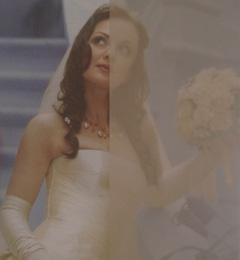
Left: 90% opacity; Right: 96% opacity
(Viewed from back of paper)
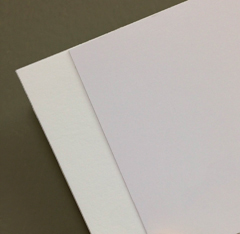
Left: Whiteness 99.5%; Right: Whiteness 104%
|
|
Visit our Fine Art Prints service page today. You can browse and learn more about our great selection of high quality papers, or place your print order now.
If you have any questions about the fine art or photographic papers the offer, or any of the products or services offered here at KeenART Media, please do not hesitate to contact us. Our knowledgeable staff are always happy to answer your enquiries and provide suggestions or advice.
|
| Sample Packs - Fine art papers: |
 |
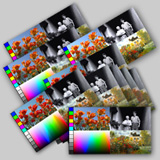 |
The KeenARTS Sample Pack allows photographers and artists to see and compare the KeenARTS's sample image printed on different papers and media prior to ordering online prints.
Size: 8-3/4" x 5" sample pack, 14 sheets
Order the sample pack online: Sample Packs - Fine art papers
|
|

|



|
USA Giclee On Canvas, Fine Art Printing - Art Scanning & Reproductions - Handmade Oil Paintings - Custom Wood Panels, Metal Picture Framing - Block/Plaque Mountings, Large Format Dry Mounting & Lamination - Art Supplies: Stretcher Bars, Cradled Wood Panels and Artist Canvas - Collages On Canvas - Plexi/Acrylic Face Mounts - Block Acrylics, Fabric Printing, Dye Sublimation - Cityscape Skyline Prints, Resin, Photo Gifts and more...
Frame Assembly Guide - Dovetail System
USA Laser Engraving & Cutting Services
|
|
© 2002-2024 - KeenART Media Ltd.
|
|
| |
|
